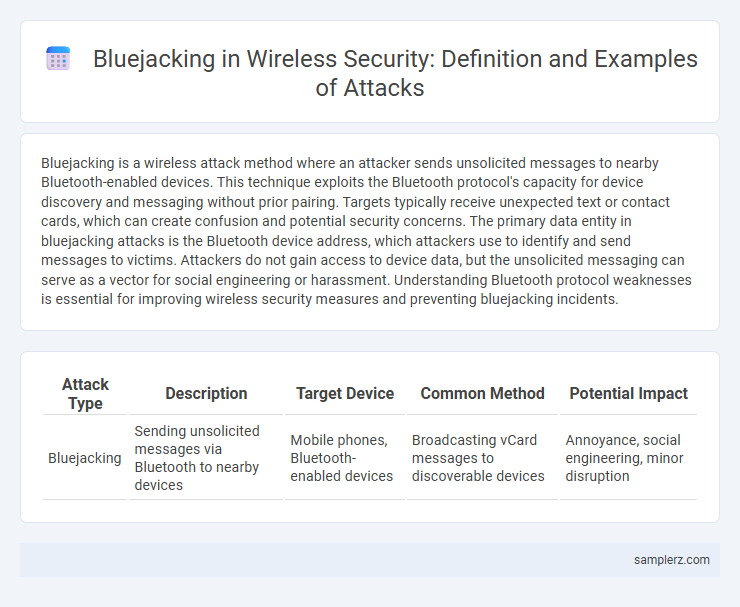Bluejacking is a wireless attack method where an attacker sends unsolicited messages to nearby Bluetooth-enabled devices. This technique exploits the Bluetooth protocol's capacity for device discovery and messaging without prior pairing. Targets typically receive unexpected text or contact cards, which can create confusion and potential security concerns. The primary data entity in bluejacking attacks is the Bluetooth device address, which attackers use to identify and send messages to victims. Attackers do not gain access to device data, but the unsolicited messaging can serve as a vector for social engineering or harassment. Understanding Bluetooth protocol weaknesses is essential for improving wireless security measures and preventing bluejacking incidents.
Table of Comparison
| Attack Type | Description | Target Device | Common Method | Potential Impact |
|---|---|---|---|---|
| Bluejacking | Sending unsolicited messages via Bluetooth to nearby devices | Mobile phones, Bluetooth-enabled devices | Broadcasting vCard messages to discoverable devices | Annoyance, social engineering, minor disruption |
What is Bluejacking?
Bluejacking is a wireless attack technique that involves sending unsolicited messages over Bluetooth to nearby devices without the recipient's consent. It exploits Bluetooth's default settings to inject text or vCards into the target device, often causing confusion or distraction. This form of attack highlights vulnerabilities in Bluetooth security protocols and the importance of managing device visibility.
How Bluejacking Works in Wireless Attacks
Bluejacking exploits Bluetooth technology by sending unsolicited messages to nearby devices within a limited wireless range, usually up to 10 meters. Attackers create and send contact cards, often called vCards, containing text messages to unsuspecting recipients' Bluetooth-enabled devices without pairing or authorization. This method leverages the Bluetooth discovery mode to deliver messages, causing annoyance or social engineering opportunities without directly compromising device security.
Real-World Examples of Bluejacking Incidents
Bluejacking incidents often involve unsolicited messages sent via Bluetooth to nearby devices, exemplified by cases in crowded public places like airports or shopping malls where attackers send anonymous text messages disrupting user experience. One notable example occurred in 2004, when a large-scale bluejacking campaign targeted conference attendees, flooding devices with spam messages that caused confusion and temporary communication breakdowns. These incidents highlight the vulnerability of unsecured Bluetooth connections and underscore the importance of robust device security settings to prevent unauthorized access.
Common Techniques Used in Bluejacking
Bluejacking commonly exploits Bluetooth protocol vulnerabilities by sending unsolicited, anonymous text messages or vCards to nearby devices without their consent. Attackers often use discovery mode to identify reachable devices and employ specialized software or mobile apps designed to inject unwanted messages into recipients' inboxes. This technique leverages default device settings that accept incoming data automatically, making users susceptible to spam and phishing attempts.
Devices Vulnerable to Bluejacking Attacks
Devices vulnerable to bluejacking attacks primarily include Bluetooth-enabled smartphones, tablets, and laptops that have their Bluetooth settings set to discoverable mode. Older models or those without updated security patches are especially susceptible as they lack advanced authentication protocols, making it easier for attackers to send unsolicited messages. Wearables and certain IoT devices with active Bluetooth connections also face heightened risks due to weaker security controls.
Bluejacking vs. Bluesnarfing: Key Differences
Bluejacking involves sending unsolicited messages to nearby Bluetooth devices without accessing data, primarily as a harmless prank or marketing tool, whereas Bluesnarfing is a malicious attack that exploits Bluetooth vulnerabilities to steal sensitive information such as contacts, messages, and files. Bluejacking does not require device pairing or authentication, making it simpler but less threatening, while Bluesnarfing demands bypassing security measures to gain unauthorized data access. Understanding these key differences is crucial for implementing effective Bluetooth security protocols and minimizing wireless attack risks.
Impact of Bluejacking on Wireless Security
Bluejacking exploits Bluetooth technology by sending unsolicited messages to nearby devices, often causing confusion and disruption in wireless communication environments. The impact on wireless security includes potential privacy breaches, unauthorized data exposure, and increased vulnerability to subsequent attacks like Bluebugging and device tracking. Although primarily considered a nuisance, bluejacking can undermine user trust in wireless networks and complicate the management of secure Bluetooth connections.
Prevention Strategies Against Bluejacking
Preventing bluejacking attacks involves disabling Bluetooth visibility or setting devices to non-discoverable mode, which reduces exposure to unsolicited messages. Regularly updating device firmware and using strong authentication protocols help block unauthorized Bluetooth connections. Employing Bluetooth security settings, such as pairing only with trusted devices and avoiding public Bluetooth usage, significantly lowers the risk of bluejacking threats.
Legal and Ethical Implications of Bluejacking
Bluejacking involves sending unsolicited Bluetooth messages, often perceived as harmless pranks, but it raises significant legal concerns under unauthorized access and privacy laws in many jurisdictions. Ethically, bluejacking breaches personal boundaries and consent, potentially causing discomfort or fear among recipients, highlighting the importance of respecting digital privacy and communication norms. Organizations must educate users about these implications to mitigate risks and enforce policies that prevent abusive or intrusive wireless communication practices.
Future Trends in Bluetooth Security and Bluejacking
Bluejacking, a method of sending unsolicited messages via Bluetooth to nearby devices, will evolve as Bluetooth technology advances, posing new security challenges. Future trends in Bluetooth security emphasize enhanced encryption protocols, improved device authentication mechanisms, and AI-driven intrusion detection to mitigate risks associated with bluejacking attacks. Emerging Bluetooth Low Energy (BLE) standards and increased adoption of secure pairing methods aim to reduce vulnerabilities exploited in bluejacking incidents, safeguarding wireless communications.

example of bluejacking in wireless attack Infographic
 samplerz.com
samplerz.com